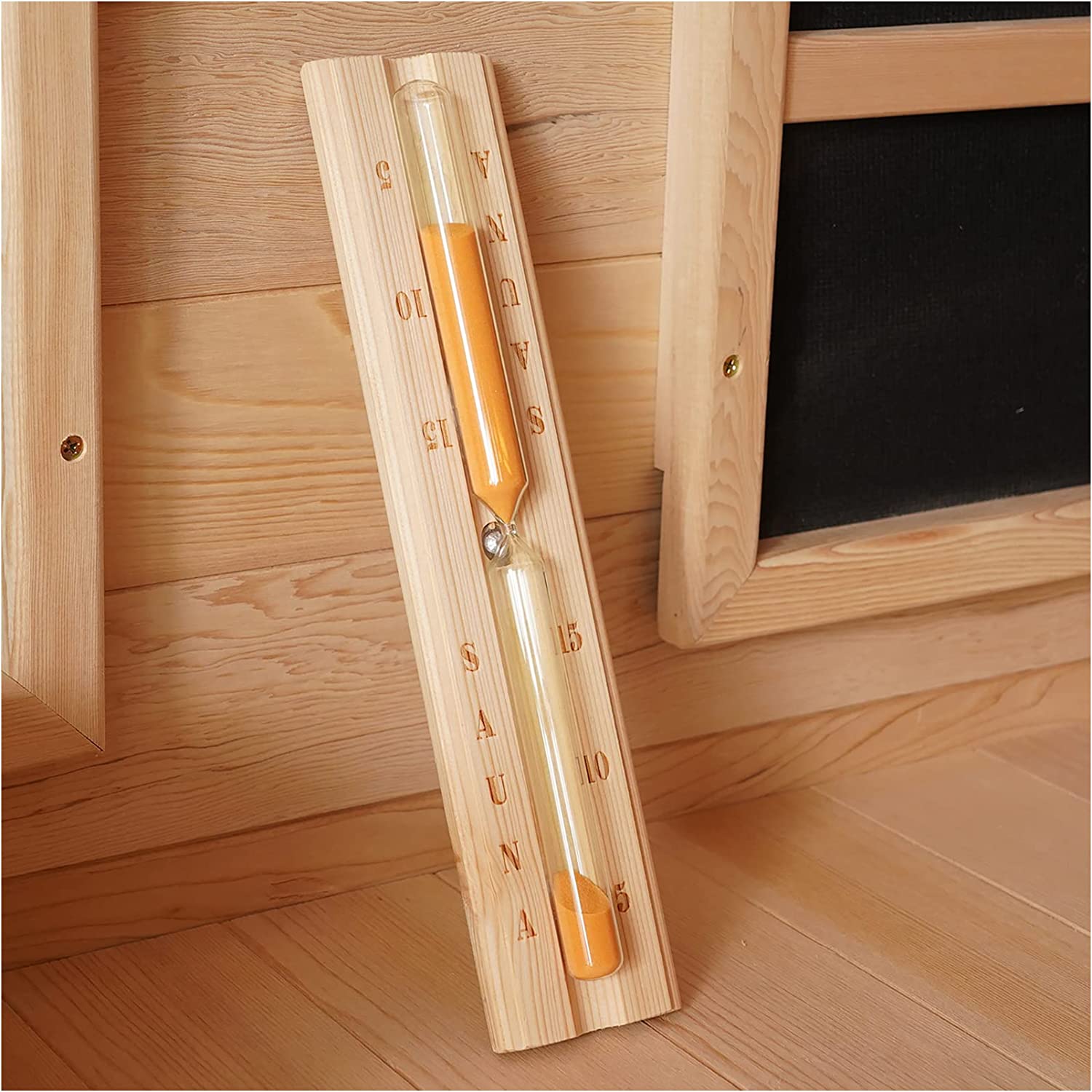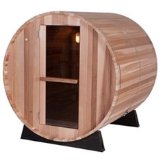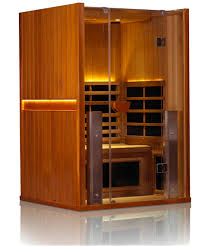How Long Should You Stay In A Sauna?

Just how much time should you spend in the sauna? Well, there is really no specific amount of time of time that applies to every user universally. There are a number of factors at play, and the ideal time for you may be vastly different than the ideal time for someone else.
Let's take a closer look...
Saunas are a way of life in Scandinavia, having been used for thousands of years. They started out as simple earth pits covered by animals skins. In fact, the word “sauna” comes from the Finnish for “earth”.
Over the years, they have evolved to include wood stoves, electric heaters or the latest innovation in saunas, infrared technology. There are even “smoke” saunas which don’t include a chimney, so the smoke from the wood burning fire must be vented and then the door is closed to retain the residual heat.
No matter the heat source, the principal behind sauna use remains the same across the board: the heat of the sauna raises your body temperature and produces sweat, which removes toxins from the body and produces a range of therapeutic effects, from improved cardiac function to healthier skin, and even stress relief.
In Finland, where sauna use is a social experience, stress relief is the primary focus. The Finns come together in the sauna to relax, enjoy each other’s company and let the cares of the world literally melt away.
Of course, as with anything that provides benefits there are also potential risks involved with sauna use. This leads to the obvious question, how long should you stay in a sauna?
It’s a point worth considering and it has actually been the subject of several studies, most by Finnish scientists and experts.
The general rule of thumb when it comes to the length of sauna sessions is to start slowly and gradually increase your time rather than trying to break an endurance record right off the bat.
Because it is used as a social event in Finland, and most users are used to being in the sauna on a regular basis, sessions there can last much longer but for the average user, shorter sessions are usually recommended.
Beginners who have limited sauna experience should not use a sauna for more than 5 to 10 minutes at a time, although you can enjoy multiple sessions with a short cool off period in between.
Over time, as you become more used to the effects of the sauna you can gradually increase the time for each session, though for most people you shouldn’t stay in for longer than 20 minutes at the most.
Obviously, the longer you remain in the sauna the greater the benefits to your body, and 19-20 minutes is usually what’s required to get the maximum benefits. That being said, the time of a session is really dictated by your personal preference and your individual heat tolerance.
How Long Should You Stay in Different Types of Saunas?
Though all saunas work on the same basic principle of raising the body temperature and causing you to sweat, not all types of sauna are created equally.
Most traditional saunas, including wood-burning, electric and smoke, work at a higher temperature and your body will likely feel the effects more quickly, which is why individual sessions are generally limited to 5-10 minutes and no more than 15-20 minutes maximum.
Infrared saunas, which work by radiating heat and warming up your body directly rather than warming up the air, function at lower temperatures which means the effects can be more subtle.
Not surprisingly, this means that most people can usually tolerate a slightly longer session in an infrared sauna, though 20 minutes is still the recommended average time.
How long should you stay in a dry sauna (traditional)?
A traditional dry sauna typically ranges from 160°F to 200°F or so with very low humidity.
- Beginners: Start with 8–12 minutes.
- Experienced users: Up to 15–20 minutes per session is common.
- Tip: Always cool down and hydrate between sessions if you plan on doing multiple sessions at a time.
How long should you stay in a steam sauna/steam room?
Steam rooms have lower temperatures (100°F–120°F) but 100% humidity, which makes them feel hotter than they actually are.
- Beginners: Start with 10–15 minutes.
- Experienced users: Up to 20 minutes can be safe, but take breaks if you feel lightheaded.
- Tip: Because steam rooms prevent sweat from evaporating, overheating can happen faster — exit if you start to feel uncomfortably warm.
How long should you stay in an infrared sauna?
Infrared saunas operate at lower temperatures (110°F–140°F) because they heat your body directly instead of the air around you. As such is easier to stay in there for longer periods of time.
- Beginners: 15–20 minutes is a good starting point.
- Experienced users: Up to 30–40 minutes, depending on comfort.
- Tip: Hydrate before and after — you’ll sweat a lot more than you might expect at these lower temps.
How long should you stay in an infrared sauna blanket?
Infrared sauna blankets deliver similar heat benefits but in a compact, personal format.
- Beginners: Start with 15 minutes at a low setting.
- Experienced users: Gradually increase to 30–45 minutes at moderate heat.
- Tip: Use a towel layer for hygiene and never fall asleep while using one.
How long should you stay in a portable sauna?
If you’re using a portable tent-style or barrel sauna, follow the same general rules as above based on the heat source(infrared, electric, or steam).
- For most home saunas: 10–20 minutes per session is ideal, depending on temperature.
Factors to Take Into Consideration
In general, when considering how long you should stay in a sauna, there are a number of factors that you should take into consideration:
1. Your current health – the effects of sauna usage vary drastically depending on the overall health of an individual and certain factors, including age, alcohol use, and the presence of various health conditions can drastically increase your level of risk.
An article in The American Journal of Forensic Medicine and Pathology studied the effects of sauna use among a group of people in Sweden and determined that most cases of death related to sauna use involved either the use of alcohol or the presence of an underlying medical condition. Clearly, you should carefully consider your overall health before using a sauna and if you have any potential risk factors you should limit the time of your sessions.
2. How often you use a sauna – the more regularly you use a sauna, the more your body will become used to it and the better you’ll be able to tolerate the heat. Beginners will likely start to feel adverse effects sooner than experienced sauna users.
3. Whether you are sexually active – since sauna usage has been shown to have an adverse effect on sperm production in some men, if you are actively in the process of starting a family you may want to reduce the time spent in the sauna.
4. If you have metabolic disorders or are obese – Individuals with metabolic disorders or those considered obese may not be able to regulate heat as easily and therefore they run a far greater risk of experiencing adverse effects from sauna use.
5. If you are using the sauna with children – often, families will use the sauna together, which can be a wonderful social event, but you need to remember that children’s bodies are less heat tolerant than adults and as a result they can experience adverse reactions more quickly. If you are including your children in a sauna session, you’ll likely want to limit your time to avoid any potential harm.
6. If you are currently pregnant – the rise in body temperature caused by saunas can actually be harmful to a developing fetus, even in the early stages of pregnancy, resulting in birth defects and other health issues, so if you are pregnant it’s best to consult with your doctor before using a sauna.
7. If you have heart disease or high blood pressure – while sauna use can have some cardiovascular benefits, there are also considerable risks for individuals with heart disease or high blood pressure, so you need to weight the benefits and risks carefully before deciding whether to use a sauna and how long to stay in.
If you have any specific questions or have an underlying heath concern, you should consult with your doctor for a recommendation about the safety of using a sauna. Sauna use can benefit and even improve your health in some cases, but you always need to balance that out against any potential risks before deciding what’s right for you.
Using the Sauna after a Workout

Many people enjoy a sauna session after a workout as a way of relaxing and “recharging” their bodies. There have been studies that show sauna use aiding in post-workout recovery and even improving athletic performance.
That being said, it is important to let your body cool down after your workout for at least 10 minutes before entering the sauna to allow your heart rate to stabilize.
You should also ensure that you are properly hydrated before getting into the sauna, as regular exercise can increase fluid loss through sweating and the sweating in the sauna may exacerbate that.
Generally speaking, the amount of time to spend in the sauna after a workout is the same as that for a regular sauna session, 5-10 minutes to begin with, gradually increasing to 15-20 minutes as you gauge your body’s reaction to the heat.
How Do I Know When I’ve Been In Too Long?
Since saunas expose your body to increased heat stress, that can raise your body temperature and heart rate and lead to dehydration due to excessive sweating. All of these conditions can have a detrimental effect on your health, so you need to watch for signs that you’ve been in the sauna for too long.
Each individual will react differently to the heat extremes experienced in the sauna, so you should listen to your own body. Some people can just tolerate the heat better than others. For the average healthy person a 10-20 minute sauna session will be perfectly tolerable, but some may not be able to last that long.
Proper hydration is essential to maintain safety during your sauna session. As you will be losing fluids by sweating, you’ll need to replace them in order to prevent dehydration. Signs of dehydration can include dizziness, headaches and in some cases fainting.
No matter how experienced you are with sauna use, it’s always a smart idea to use some safety precautions in order to prevent any negative side effects. side from drinking plenty of water to avoid dehydration, you should also avoid using alcohol and always have a sauna buddy so you’ll have backup should any unforeseen problems occur.
Of course, you can always adjust the temperature on the sauna to achieve maximum benefit without adding to your risks so you can get the most from your sauna session.
What's the Bottom Line?
When it comes to saunas, there is no denying the many potential health benefits, including improved cardiovascular function, reduced inflammation and muscle soreness, improved skin health and even a reduced risk of dementia. On top of all that, it can just be a wonderfully relaxed and friendly social experience that helps to reduce stress.
Remember, using a sauna is supposed to be a pleasant experience, so you don’t want to overdo and you should exercise the proper precautions. Take it slow, starting out with short sessions and gradually increasing your time so that your body has the opportunity to adjust to the heat, and remember to stay properly hydrated at all times.
In order to maximize the benefits, you need to use common sense to determine the proper length of your sauna sessions. The best gauge you have for that is your own body. Listen to what it’s telling you and if you feel like you are suffering a negative response to the heat, then it’s time to cut your session short.
Infrared Saunas
Sauna Heaters

How to Install a Wood Sauna Heater
Sauna Kits

Buying Guide




